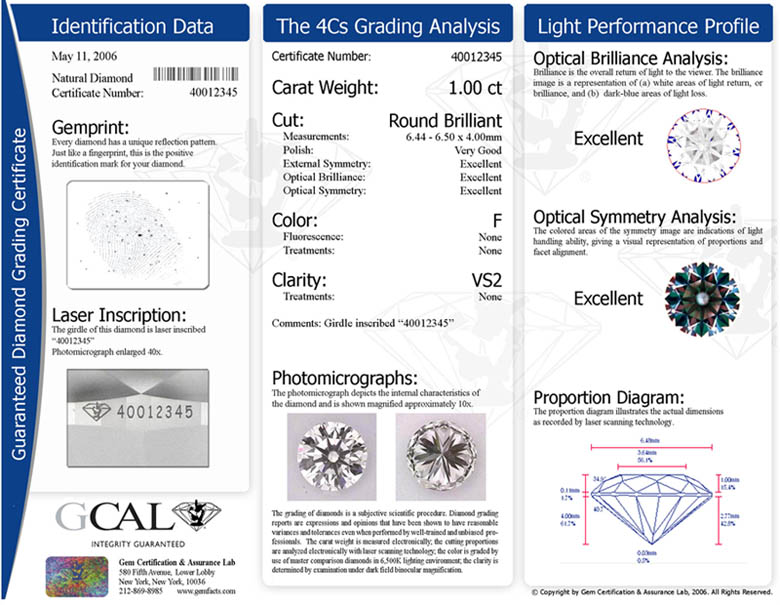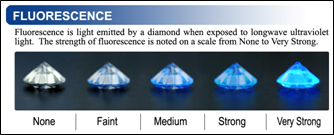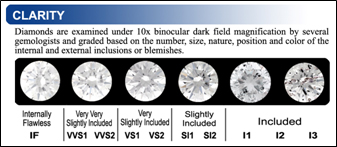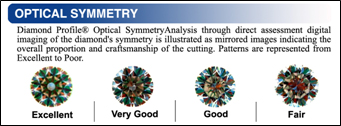
Unique certificate number with a corresponding barcode.
This number is maintained in the GCAL database along with the digital identification of the diamond and all of its related grading
information.
Gemprint image of this diamond.
Gemprint is a technology that can uniquely identify a diamond. Just like a fingerprint, each diamond
has a distinctive and repeatable pattern. A Gemprint is produced by aiming a low energy laser at a faceted
diamond creating a unique reflection pattern.
Photomicrograph of the laser inscription
This inscription is most easily seen at 20 power magnification or higher. The inscription does not affect the
diamond's clarity or color grades, as it is only about 5 microns deep-about one tenth the width of a human hair.
Carat Weight
There are 5 carats in one gram. GCAL weighs diamonds on electronic balances according to the international
carat weighting standard.
The word carat spelled with a 'C' refers to the standard unit of weight used for gemstones. The word karat
spelled with a 'K' refers to the karatage of pureness of gold.
Cut.
The first line in this section states the shape of the diamond. The standard way of describing a diamond's
shape is to state the outline, such as round or heart, and then described the faceting style, such as brilliant
or step. Brilliant faceting consists primarily of triangular and kite shaped facets, whereas step faceting
consists primarily of rectangular and trapezoidal shaped facets.
Measurements.
Diamonds are measured in millimeters. There are 25.4mm to the inch.
The measurements listed here refer to the minimum - maximum x depth for round diamonds and refer to the length x width
for all other shapes.
Polish.
Polish is the freeness from scratches and the quality of the surface.
Polish is graded under 10x power magnification on a scale of: Excellent,
Very Good, Good, Fair and Poor.
External Symmetry.
External Symmetry judges the quality of the craftsmanship and facet alignment. External Symmetry is a physical quality
that is graded under 10x power magnification on a scale of: Excellent, Very Good, Good, Fair and Poor. Optical Symmetry
refers to how well a diamond handles light and is graded by means of imaging.
Optical Brilliance and Optical Symmetry.
See the Light Performance Profile to the right.
Color.
The color of diamonds is graded on a scale from D (colorless) to Z (light yellow). Color is graded in a standardized
lighting environment and each diamond is compared to a set of Master Color diamonds.
|
GCAL utilizes a unique quality control procedure for grading the color and clarity of diamonds that assures the most
accurate and consistent grading possible. At least three experienced gemologists examine and grade both the color and
the clarity of every diamond
|

|
Fluorescence.
Fluorescence is the amount of light emitted by a diamond when it is exposed to long wave ultraviolet light.
Fluorescence is an identifying characteristic of diamonds and is stated as: None, Faint, Medium, Strong or
Very Strong
|
Fluorescence is listed on GCAL's certificate because it is a permanent identifying feature. Almost half of all
diamonds will show some fluorescence when exposed to long wave ultraviolet light. Blue is the most common color of
fluorescence. When diamonds are viewed under normal lighting conditions, fluorescence is not normally visible. Also,
experts agree that fluorescence only has a negative effect on the appearance of a diamond in very rare instances.
|

|
Treatments.
All diamonds submitted to GCAL for certification are thoroughly examined to assure the detection of any treatments. A
diamond treatment is any artificial process that alters the appearance of a diamond. Any treatments detected are listed under
the Color and Clarity grades respectively.
GCAL's research lab is comprised of advanced state-of-the-art instruments along with classic gemological equipment. There are
only a handful of gemological laboratories in the world that are so well equipped to detect treated and synthetic diamonds.
One example of a color treatment is the High Pressure High Temperature (HPHT) process which can permanently alter the color of
diamonds. This is achieved using a machine to create conditions up to 2500C and pressures up to 85 kilobars. This treatment
significantly affects the value of a diamond.
Clarity.
The clarity grade conveys the presence or absence of identifying characteristics (inclusions) in a diamond; these can be thought
of as nature's birthmarks. Clarity is graded under 10x power magnification using a microscope and a loupe.
|
Grading is a subjective scientific procedure. Reasonable variances are possible, but every effort is made to eliminate inconsistencies.
GCAL utilizes a unique quality control procedure for grading the color and clarity of diamonds that assures the most accurate and consistent
grading possible. In addition, the weight is measured electronically, state-of-the-art technology is used to analyze cut, and optimal
environments are maintained for color and clarity grading.
|

|
Treatments.
All diamonds submitted to GCAL for certification are thoroughly examined to assure the detection of any treatments. A
diamond treatment is any artificial process that alters the appearance of a diamond. Any treatments detected are listed under
the Color and Clarity grades respectively.
GCAL's research lab is comprised of advanced state-of-the-art instruments along with classic gemological equipment. There are
only a handful of gemological laboratories in the world that are so well equipped to detect treated and synthetic diamonds.
One example of a clarity treatment is laser drilling. The purpose of laser drilling is to lessen the visibility of an inclusion.
This is achieved by using a laser to create channels reaching from an inclusion to the surface of a diamond. After the channel is
drilled, the diamond is soaked in an acid to either bleach or dissolve the inclusion. This treatment typically has a significant
affect on value.
Comments.
This section is used to note any important remarks about the diamond, such as inscriptions on the girdle.
Photomicrographs.
Photomicrographs of the crown (top) and pavilion (bottom) of the diamond show internal characteristics visible at
10x power magnification.
Optical Brilliance Analysis.
Brilliance is the overall return of light to the viewer. In this image, the white represents areas of light return and
the blue represents areas of light loss.
|
The Optical Brilliance image is actually a photograph of this diamond taken in a special lighting environment. The image is
then analyzed by a proprietary computer program to calculate the percentage of brilliance. This measurement is 99% repeatable.
Optical Brilliance is graded on a scale from Excellent to Poor.
|

|
Optical Symmetry Analysis.
What makes a diamond beautiful is how well it plays with light - GCAL measures each individual diamond's Light Performance.
|
The Optical Symmetry image shows the balance of this diamond; the more even the pattern, the better the symmetry. The colored
areas give a visual representation of proportions and facet alignment. It is a direct assessment of craftmanship, the care taken
in the precision of the cutting. Optical Symmetry is reported on a scale from Excellent to Poor.
|

|
Proportion Diagram.
The Proportion diagram is an actual to-scale profile of the diamond. All the angles and measurements are represented. Proportions
such as table percentage and depth percentage are illustrated here.





